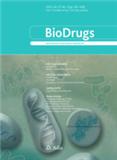| 投稿方式:官网投稿 |
- 栏目频次
- 单位占比
-
热词

-
更多
期刊简介
- BioDrugs《生物药物》(双月刊). BioDrugs covers the development and therapeutic application of biotechnology-based pharmaceuticals and diagnostic products for the treatment of human disease.
-
基本信息
- 期刊名称:BioDrugs《生物药物》
- 主管单位:《生物药物》
- 主办单位:BIODRUGS
- 国内刊号:
- 国际刊号:ISSN1173-8804;E-ISSN1179-190X
-
- 出刊日期:http://www.adisonline.info
- 期刊定价:0
-
- 邮发代码:2区
-
- 所在省区:新西兰
- 邮政编码:
- 联系地址:ADIS INT LTD, 5 THE WAREHOUSE WAY, NORTHCOTE, NEW ZEALAND, AUCKLAND, 0627
-
投稿信息
-
- 学科分类:
- 版面费用:4.40%
-
- 字数要求:0
- 查重要求:-
-
- 复合因子:0
- 综合因子:0
-
- 审 稿 费:否
- 稿费:否
- 本刊可发:0
- 特殊属性:英语
-
联系方式
- 投稿网址:https://www.editorialmanager.com/bdra
- 官网网址:
- 电话传真:
- 电子邮箱:
- 微信公众号:

